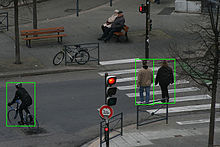
Computer vision tasks include methods for acquiring, processing, analyzing and understanding digital images, and extraction of high-dimensional data from the real world in order to produce numerical or symbolic information, e.g. in the forms of decisions. Understanding in this context means the transformation of visual images into descriptions of the world that make sense to thought processes and can elicit appropriate action. This image understanding can be seen as the disentangling of symbolic information from image data using models constructed with the aid of geometry, physics, statistics, and learning theory.

Physical security describes security measures that are designed to deny unauthorized access to facilities, equipment, and resources and to protect personnel and property from damage or harm. Physical security involves the use of multiple layers of interdependent systems that can include CCTV surveillance, security guards, protective barriers, locks, access control, perimeter intrusion detection, deterrent systems, fire protection, and other systems designed to protect persons and property.

Closed-circuit television (CCTV), also known as video surveillance, is the use of video cameras to transmit a signal to a specific place, on a limited set of monitors. It differs from broadcast television in that the signal is not openly transmitted, though it may employ point-to-point (P2P), point-to-multipoint (P2MP), or mesh wired or wireless links. Even though almost all video cameras fit this definition, the term is most often applied to those used for surveillance in areas that require additional security or ongoing monitoring.

Surveillance is the monitoring of behavior, many activities, or information for the purpose of information gathering, influencing, managing or directing. This can include observation from a distance by means of electronic equipment, such as closed-circuit television (CCTV), or interception of electronically transmitted information like Internet traffic. It can also include simple technical methods, such as human intelligence gathering and postal interception.
An intrusion detection system is a device or software application that monitors a network or systems for malicious activity or policy violations. Any intrusion activity or violation is typically reported either to an administrator or collected centrally using a security information and event management (SIEM) system. A SIEM system combines outputs from multiple sources and uses alarm filtering techniques to distinguish malicious activity from false alarms.
Motion detection is the process of detecting a change in the position of an object relative to its surroundings or a change in the surroundings relative to an object. It can be achieved by either mechanical or electronic methods. When it is done by natural organisms, it is called motion perception.

A security alarm is a system designed to detect intrusions, such as unauthorized entry, into a building or other areas, such as a home or school. Security alarms protect against burglary (theft) or property damage, as well as against intruders. Examples include personal systems, neighborhood security alerts, car alarms, and prisons.

A passive infrared sensor is an electronic sensor that measures infrared (IR) light radiating from objects in its field of view. They are most often used in PIR-based motion detectors. PIR sensors are commonly used in security alarms and automatic lighting applications.

A motion detector is an electrical device that utilizes a sensor to detect nearby motion. Such a device is often integrated as a component of a system that automatically performs a task or alerts a user of motion in an area. They form a vital component of security, automated lighting control, home control, energy efficiency, and other useful systems.

An Internet Protocol camera, or IP camera, is a type of digital video camera that receives control data and sends image data via an IP network. They are commonly used for surveillance, but, unlike analog closed-circuit television (CCTV) cameras, they require no local recording device, only a local area network. Most IP cameras are webcams, but the term IP camera or netcam usually applies only to those that can be directly accessed over a network connection.
Perimeter surveillance radar (PSR) is a class of radar sensors that monitor activity surrounding or on critical infrastructure areas such as airports, seaports, military installations, national borders, refineries and other critical industry and the like. Such radars are characterized by their ability to detect movement at ground level of targets such as an individual walking or crawling towards a facility. Such radars typically have ranges of several hundred metres to over 10 kilometres.
A flame detector is a sensor designed to detect and respond to the presence of a flame or fire, allowing flame detection. Responses to a detected flame depend on the installation, but can include sounding an alarm, deactivating a fuel line, and activating a fire suppression system. When used in applications such as industrial furnaces, their role is to provide confirmation that the furnace is working properly; it can be used to turn off the ignition system though in many cases they take no direct action beyond notifying the operator or control system. A flame detector can often respond faster and more accurately than a smoke or heat detector due to the mechanisms it uses to detect the flame.
Countersurveillance refers to measures that are usually undertaken by the public to prevent surveillance, including covert surveillance. Countersurveillance may include electronic methods such as technical surveillance counter-measures, which is the process of detecting surveillance devices. It can also include covert listening devices, visual surveillance devices, and countersurveillance software to thwart unwanted cybercrime, such as accessing computing and mobile devices for various nefarious reasons. More often than not, countersurveillance will employ a set of actions (countermeasures) that, when followed, reduce the risk of surveillance. Countersurveillance is different from sousveillance, as the latter does not necessarily aim to prevent or reduce surveillance.

The Unattended Ground Sensor (UGS) are a variety of small sensors, generally covert, dedicated to detect and identify activities on the ground such as enemy soldiers or vehicles. UGS come as systems with an integrated communication network and processing capabilities.

Smart Eye AB, is a Swedish artificial intelligence (AI) company founded in 1999 and headquartered in Gothenburg, Sweden. Smart Eye develops Human Insight AI, technology that understands, supports and predicts human behavior in complex environments. Smart Eye develops and deploys several core technologies that help gain insights from subtle and nuanced changes in human behavior, reactions and expressions. These technologies include head tracking, eye tracking, facial expression analysis and Emotion AI, activity and object detection, and multimodal sensor data analysis.
Fraud represents a significant problem for governments and businesses and specialized analysis techniques for discovering fraud using them are required. Some of these methods include knowledge discovery in databases (KDD), data mining, machine learning and statistics. They offer applicable and successful solutions in different areas of electronic fraud crimes.
Video content analysis or video content analytics (VCA), also known as video analysis or video analytics (VA), is the capability of automatically analyzing video to detect and determine temporal and spatial events.

The Domain Awareness System is the largest digital surveillance system in the world as part of the Lower Manhattan Security Initiative in partnership between the New York Police Department and Microsoft to monitor New York City. It allows the NYPD to track surveillance targets and gain detailed information about them, and is overseen by the counterterrorism bureau.
Sound recognition is a technology, which is based on both traditional pattern recognition theories and audio signal analysis methods. Sound recognition technologies contain preliminary data processing, feature extraction and classification algorithms. Sound recognition can classify feature vectors. Feature vectors are created as a result of preliminary data processing and linear predictive coding.
Human bycatch is a term for people who are unintentionally caught on film, in photos, or acoustically recorded on equipment used to monitor wildlife or habitats for the purpose of conservation, or environmental law enforcement. It comes from the term bycatch, which is used in fishing practices to designate non-target species that are caught in a fishing net. Nearly every remote monitoring study contains human by-catch, yet there are no standardized rules or policies regarding what the researchers can or should do with their data.












